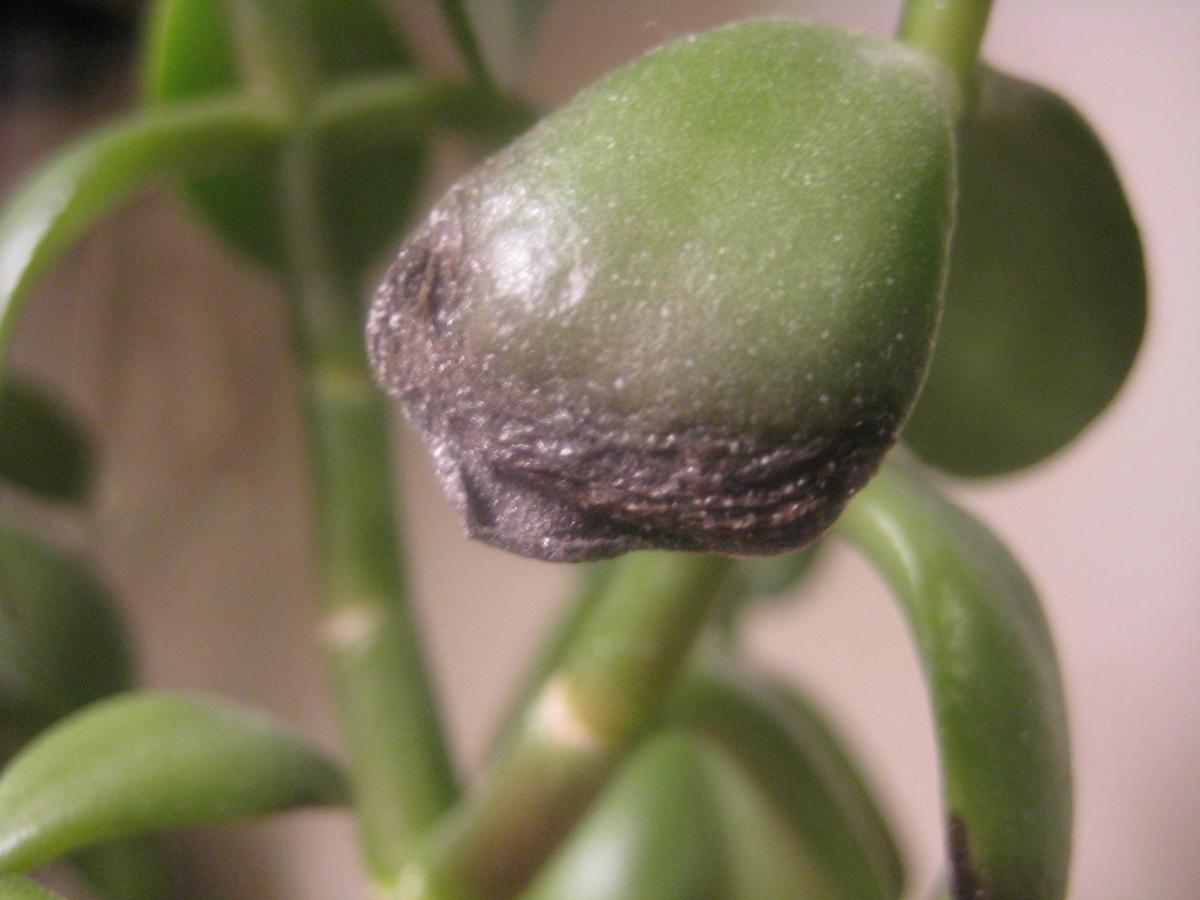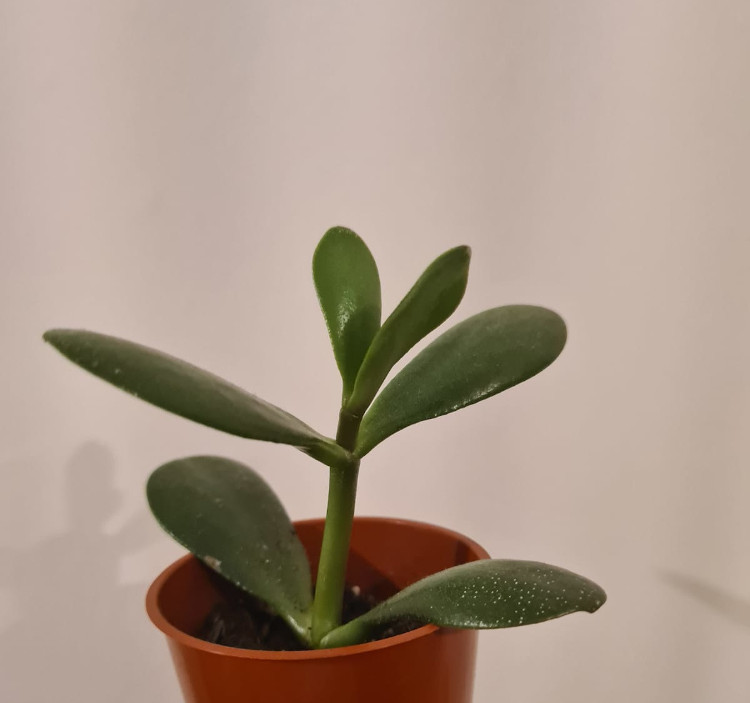
Root rot in jade plants, which is brought on by wet soil surrounding the roots or high humidity, is the reason why the leaves and stems turn black. Edemas, or black spots on jade plant leaves, are brought on by overwatering and poorly draining soils.
To find out why your Jade plant is becoming black and how to save it, continue reading.
Table of Contents
Over Watering Promotes Rot That Turns Jade Black
Native to South Africa, jade plants require dry soil, abundant light, and infrequent rainfall in order to thrive.
Jade plants are uniquely adapted to growing in conditions that are nearly desert-like, with minimal precipitation and soil that drains very quickly (thanks to their thick leaves).
Jade is therefore extremely sensitive to overwatering when grown by gardeners, which can result in stress symptoms like:
- leaf stains in the color black (edema).
- dingy leaves (root rot).
- brown stems (root rot).
Small black or dark spots on jade plants are edemas, which develop when the rate of transpiration (water loss through the leaves) is greater than the rate of excessive water intake at the roots.
Root rot is a fungus that causes black leaves and stems.
Overwatering is typically the main cause of black spots, leaves, and stems, which are all brought on by an excess of moisture around the roots.
Since jade plants can withstand droughts, it’s crucial to mimic the native habitat by giving them less regular waterings.
how to keep it.
Reduce the amount of watering the Jade plant receives so that the soil dries up in between applications.
Use a cocktail stick to poke into the dirt to find out with this technique. Leave the watering off for a few more days if the soil on the stick is only slightly moist. Give the jade plant a good soak if the stick is dried out.
Jade plants prefer a watering schedule that includes a thorough watering that causes water to drip out of the bottom of the pot, followed by a period during which the soil around the roots is allowed to dry out. This mimics the natural conditions of a downpour of rain followed by a drought.
(To find out how frequently and how much to water jade plants for your environment, read my post on how to water jade plants.)
Jade plants are resilient and can bounce back from leaf black spots if you have a better watering schedule in place.
The plant may suffer and may develop rot if there are additional sources of excessive soil moisture, such as slow-draining soil. The leaves may heal on their own in these cases.
It’s probably root rot if the leaves and stems are becoming black.
To save the Jade plant, remove any black leaves and stem segments. This will stop the rot from spreading throughout the plant.
Once a jade plant has developed rot, it might be challenging to restore it, but one technique to guarantee recovery is to cut off the healthy green leaves or plant parts that are free of black markings for multiplication.
Jades are incredibly simple to grow and spread. Watch this instructive YouTube video to learn how to spread Jade.
Top Jade Plant Watering Advice
- Jade plants should be watered at the base rather than the top because watering with moist leaves might reduce transpiration and increase the danger of the leaves becoming black.
- When the soil has dried out, water the jade plant early in the morning to give it time to lose some extra moisture via the leaves over the day so that it can balance its level of moisture.
- If a plant is watered at night when it is dormant, the chance of rot and black leaves is increased because the plant will be sitting in wet soil.
- In the winter, watering should be drastically reduced because jade plants enter a dormant state and only need to be watered once a month.
Slow Draining Soils Promote Rot That cause Black Leaves and Stems
When the potting soil retains too much moisture, the result is similar to overwatering in that the roots decay and turn black due to the excess moisture.
Jade plants prefer potting soil that has drainage qualities similar to those of their natural rocky home in South Africa.
Rot or black stains on your foliage are most likely caused by your Jade plant growing in unadjusted compost.
Jade plants need a particular potting mixture designed for succulents and cacti (which are widely available from garden centers and on amazon).
The perfect drainage features and particle size of specialized potting mixes enable water to drain away rapidly from the roots of your Jade plant and reduce the risk of rot.
This keeps the plant healthy and lessens the likelihood of the leaves becoming black.
Similar to an overwatered Jade plant, it could need careful trimming using sterile pruning shears to remove any blackened Jade portions and stop the rot from spreading to healthy areas of the plant.
If your jade plant has been in damp soil for an extended period of time, cutting off healthy leaves and stem portions for propagation may be the only option left to rescue it.
(Read my article on how to save a dying jade plant for additional details.)
The jade plant may maintain good health and thrive for up to 100 years or more with the proper soil drainage and watering schedule.
Pots Without Drainage Cause Jade Plants to Turn Black
If jade plants are placed in a pot without drainage holes in the base or if the drainage holes are plugged so that excess water cannot easily drain, the jade plants will turn black.
Without enough drainage, water will collect around the roots of your Jade plant, leading to root rot and the blackening of the leaves and stems.
Therefore, you must repot your Jade plant as soon as you can into a container with drainage holes to stop further damage and more blackening of the leaves.
It should be emphasized, though, that pots with poor drainage are not the sole pot-related cause of the bluish-black tinge that affects jade leaves:
- blockage of drainage pores by roots. Jade plants can last a very long time, so if yours has been in the same pot for a while, there’s a risk that the roots have grown to encircle the pot and cover the drainage hole, which slows down water evaporation and encourages excess moisture that can lead to rot.
- In order to avoid water pouring into the house after watering, jade plants are frequently planted indoors with a saucer or tray underneath the pot. If the tray or saucer is not routinely empty, water can collect underneath the plant and keep the soil soggy, causing rot and turning the leaves black.
- Jade plants are occasionally grown in very common plastic pots before being transferred to beautiful pots for indoor display. Since attractive exterior pots frequently lack drainage holes, water can accumulate in the bottom and lead to rot.
It is very important to plant jade plants in posts with drainage holes in the base and to make sure that the excess water can readily drain from the base after watering since jade plants need dry soil to avoid the conditions that turn the leaves and stems black.
Plants suffering from overwatering or poorly draining soils, similar to Jade, It’s possible that the Jade plant can only live by being pruned to leave healthy growth. Of course, you may easily save your plant by propagating Jade from cuttings and leaves.
High Humidity Can Contribute to Leaves Turning Black

Leaves may become black if there is excessive humidity in your environment or residence.
Lower rates of transpiration (water loss) from your jade plant’s leaves, which results in water stress and can color your plant black, are caused by higher levels of humidity.
There are a few things that can cause the humidity levels for Jade plants in a house to be higher:
- watering from above. Always water Jade plants at the base rather than overhead, as was previously mentioned in this post but is still important to emphasize. A humid microclimate is produced by water on the leaves, which lowers transpiration.
- Jade plants in moist house interiors. Showering or cooking can produce a lot of steam in rooms like bathrooms or kitchens, which can increase the humidity.
- Jade plants are especially susceptible to turning black in naturally humid locations (like Florida), making complete sun exposure and putting them in a breezy place even more crucial.
Place your Jade plant in broad light and, ideally, in the line of a breeze from an open window to prevent still air in order to reduce humidity. Additionally, avoid finding Jade in a stuffy space.
Even though high humidity isn’t always the reason why jade plants become black, it is frequently a big contributing element. As a result, jade plants can develop healthily with proper watering techniques, well-draining soil, and pots with good drainage.
Key Takeaways:
- Jade plant stems and leaves turn black as a result of rot brought on by too much moisture around the roots. Black patches on the leaves of the jade plant are caused by overwatering and poorly draining soils.
- The most frequent causes of jade plants becoming black are over watering and poorly draining soils. High humidity and root rot are both brought on by pots with no drainage holes.
- To avoid Jade from going black, try to mimic the growing circumstances of the plant’s native South Africa, which include full sun, occasional watering, a breezy position, and grittier soil that drains well.
- Cut back any stems or leaves that are black to stop the rot from spreading and save the jade plants. Use the healthy leaves or cuttings for propagation if there is considerable rot.
